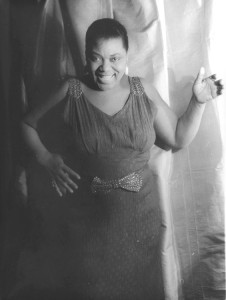Jazz Appreciation Month: Bessie Smith
April 13, 2018
April is Jazz Appreciation Month (JAM) in the United States. Jazz is a kind of music that is often considered the only art form truly native to the United States. The Smithsonian Institution’s National Museum of American History began JAM in 2002. JAM is meant to encourage people to participate in and study jazz, attend concerts, listen to jazz recordings, read books about jazz, and learn about the lives of famous jazz musicians. World Book is celebrating JAM by featuring prominent jazz musicians born in the month of April. This year, we begin with Bessie Smith, who was born on April 15, 1894. One of the finest blues singers in the history of jazz, Smith was popularly called “the Empress of the Blues.”

Bessie Smith was one of the finest blues singers in the history of American music. Credit: Library of Congress
A series of recordings Smith made from 1923 to 1933 rank among the best in jazz. She applied the power and beauty of her voice to simple songs. Louis Armstrong, Fletcher Henderson, and James P. Johnson were among the jazz musicians who played on her records. Smith was the highest-paid black entertainer of her day. A versatile performer, she also acted, danced, and performed comedy routines.
Smith was born in Chattanooga, Tennessee, into extreme poverty. She left home when she was a teenager to tour with a minstrel show, the Moss Stokes Company. A recording director discovered her and brought her to New York City. The black public bought millions of her records during the years of her greatest fame from 1923 to 1928. Smith’s best-known songs include “Down-Hearted Blues” and “Taint Nobody’s Bizness If I Do” (both 1923); “St. Louis Blues” (with Louis Armstrong) and “You’ve Been a Good Old Wagon” (both 1925); “Baby Doll” (1926); “A Good Man Is Hard to Find,” “After You’ve Gone,” and “Backwater Blues” (all 1927); “Nobody Knows You When You’re Down and Out” (1929); and “Gimmie a Pigfoot” (1933).

Click to view larger image
JAM – Jazz Appreciation Month Credit: Smithsonian National Museum of American History
In 1929, Smith appeared in the film St. Louis Blues. Her work was almost unknown to white audiences until shortly before her death. Smith died on Sept. 26, 1937, of injuries suffered in an automobile accident in Mississippi. She was inducted into the Rock and Roll Hall of Fame in 1989 as a performer who had an early influence on rock music. That same year, she received a Grammy Lifetime Achievement Award. In 1994, the United States Postal Service issued a commemorative Bessie Smith postage stamp.
In 2007, a historical marker commemorating Smith’s death was added to the Mississippi Blues Trail in Clarksdale, Mississippi. The marker is located at the Riverside Hotel, which was formerly the G.T. Thomas Afro American Hospital where Smith died. The Riverside Hotel itself is famous for providing lodging for traveling musicians.


